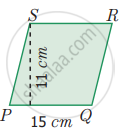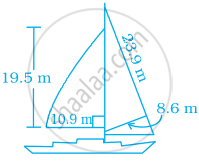Advertisements
Advertisements
Question
Find the missing value.
| Diagonal (d1) | Diagonal (d2) | Area |
| 12 mm | 180 sq.mm |
Solution
Given diagonal d2 = 12 mm; Area of the rhombus = 180 sq.m
`1/2` (d1 × d2) = 180
`1/2` (d1 × 12) = 180
d1 × 12 = 180 × 2
d1 = `(180 xx 2)/12`
d1 = 30 mm
Diagonal d1 = 30 mm
Tabulating the results we have
| Diagonal (d1) | Diagonal (d2) | Area |
| 30 mm | 12 mm | 180 sq.mm |
APPEARS IN
RELATED QUESTIONS
Lengths of the diagonals of a rhombus are 15 cm and 24 cm, find its area.
If perimeter of a rhombus is 100 cm and length of one diagonal is 48 cm, what is the area of the quadrilateral?
The perimeter of a rhombus is 40 cm. If one diagonal is 16 cm; find:
- It's other diagonal
- area
The length of the diagonals of a rhombus is in ratio 4 : 3. If its area is 384 cm2, find its side.
Find the area of rhombus PQRS shown in the following figure.
Find the missing value.
| Diagonal (d1) | Diagonal (d2) | Area |
| 19 cm | 16 cm |
Find the missing value.
| Diagonal (d1) | Diagonal (d2) | Area |
| 26 m | 468 sq.m |
The area of a rhombus is 100 sq.cm and length of one of its diagonals is 8 cm. Find the length of the other diagonal
The area of a rectangular field is 48 m2 and one of its sides is 6 m. How long will a lady take to cross the field diagonally at the rate of 20 m/minute?
Most of the sailboats have two sails, the jib and the mainsail. Assume that the sails are triangles. Find the total area sail of the sailboats to the nearest tenth.

